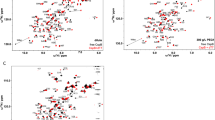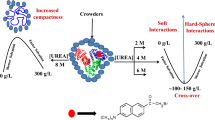Abstract
Biological macromolecules evolve and function within intracellular environments that are crowded with other macromolecules. Crowding results in surprisingly large quantitative effects on both the rates and the equilibria of interactions involving macromolecules, but such interactions are commonly studied outside the cell in uncrowded buffers. The addition of high concentrations of natural and synthetic macromolecules to such buffers enables crowding to be mimicked in vitro, and should be encouraged as a routine variable to study. In this study, we propose to understand the changes in DNA character and its modulation in presence of macromolecules such as PEG with reference to binding parameters to amino acids using fluorescence enhancement.





Similar content being viewed by others
Abbreviations
- DNA:
-
Deoxyribose Nucleic Acid
- PEG:
-
Poly Ethylene Glycol
- EB:
-
Ethidium Bromide
References
Ellis RJ (2001) Macromolecular crowding: obvious but underappreciated. Trends Biochem Sci 26:597–604
Zimmerman SB, Minton AP (1993) Macromolecular crowding: biophysical, biochemical, and physiological consequences. Annu Rev Biophys Biomol Struct 22:27–65
Marco J. Morelli, Rosalind J. Allen, and Pieter Rein ten Wolde; Effects of Macromolecular Crowding on Genetic Networks Biophys J. 2011 December 21; 101 (12): 2882–2891.
Zimmerman SB (1993) Macromolecular crowding effects on macromolecular interactions: some implications for genome structure and function. Biochim Biophys Acta 1216:175–185
Zimmerman SB, Murphy LD (1996) Macromolecular crowding and the mandatory condensation of DNA in bacteria. FEBS Lett 390:245–248
Peacocke AR, Skerrett JNH (1956) The interaction of aminoacridines with nucleic acids. Trans, Faraday Soc 52:261–79
Olins DE, Olws AL, And PH, Hippel V (1967) Model Nucleoprotein Complexes: Studies on the Interaction of Cationic Homopolypeptides with DNA; J. Mol Biol 24:157–176
Scatchard, G. (1949) The attractions of proteins for small molecules and ions. Ann. New York Acad. Sci. 51: 660–672
Irvin JL, Irvin EM (1954) The interaction of quinacrine withadenine nucleotides. J Biol Chem 210:45–56
Nakano S-i, Miyoshi D, Sugimoto N (2014) Effects of Molecular Crowding on the Structures, Interactions, and Functions of Nucleic Acids. Chem Rev 114:2733–2758
Author information
Authors and Affiliations
Corresponding author
Rights and permissions
About this article
Cite this article
Pal, P.D., Dongre, P.M. & Chitre, A.V. “Is Macromolecular Crowding Overlooked?”- Effects of Volume Exclusion on DNA-Amino Acids Complexes and Their Reconstitutes. J Fluoresc 24, 1275–1284 (2014). https://doi.org/10.1007/s10895-014-1412-1
Received:
Accepted:
Published:
Issue Date:
DOI: https://doi.org/10.1007/s10895-014-1412-1




